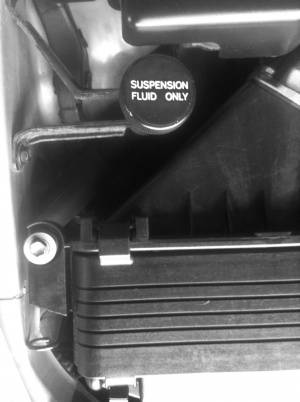Hydraulic suspension fluid: Difference between revisions
No edit summary |
No edit summary |
||
| Line 2: | Line 2: | ||
== Toyota suspension fluid == | == Toyota suspension fluid == | ||
== | The suspension fluid is considered hazardous as it contains Petroleum distillates (hydrotreated middle Petroleum distillates, solvent-refined light paraffinic) and Tricresylphosphate. | ||
=== Safety | |||
The suspension fluid is considered hazardous. Please refer to the attached safety data sheet. | |||
[[file:safety data sheet (preview).jpg|thumb|safety data sheet)|Link=File:ads.toyota.suspension.fluid.pdf]] | |||
== Changing the hydraulic fluid == | |||
To change the hydraulic fluid, drain out the old fluid, fill with fresh fluid, and bleed the system. | To change the hydraulic fluid, drain out the old fluid, fill with fresh fluid, and bleed the system. | ||
Revision as of 13:41, 9 April 2023
Toyota suspension fluid
The suspension fluid is considered hazardous as it contains Petroleum distillates (hydrotreated middle Petroleum distillates, solvent-refined light paraffinic) and Tricresylphosphate.
=== Safety
The suspension fluid is considered hazardous. Please refer to the attached safety data sheet.
Changing the hydraulic fluid
To change the hydraulic fluid, drain out the old fluid, fill with fresh fluid, and bleed the system.
Draining out the old suspension fluid
The suspension oil reservoir (and the associated drain plug) is located on the right-hand side of the vehicle, just in front of the front right wheel. The drain plug can be reached without removing the under-body-cover, but removing the cover may be easier and less messy.
Drain the old fluid and dispose of it responsibly in line with local laws and processes.
Re-fill with new suspension fluid
Toyota fluid. Colour. Quantity. Filler cap location. Plug (to remove likelihood of air being trapped in the system?)
Bleed the suspension lines to each strut
This ensures that the dirty fluid in, eg, the pump, the valve body and the hydraulic lines is also refreshed. It does however not directly refresh any fluid that is already in each of the suspension struts and accumulators.
To properly and refresh the "final" fluid requires, eg, physical removal and emptying of the struts and accumulators. Alternatively,
